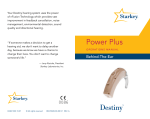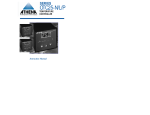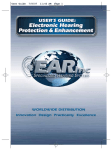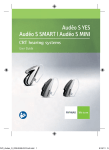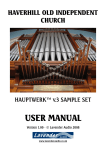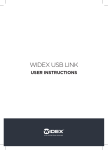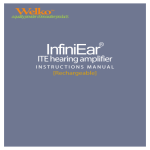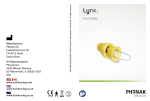Download Wi Series RIC 13 Operations Manual
Transcript
™ RIC 312 (Receiver-In-Canal) OPERATIONS MANUAL Table of Contents Overview RIC 312 Overview..................................................... 4 Preparation Batteries................................................................... 5 Battery Indicators..................................................... 7 Tamper Resistant Battery Compartment.................. 7 Insertion and Removal.............................................. 9 Operation On & Off................................................................. 11 Switch: Volume Control & Multimemory ................. 11 Directional Settings................................................ 14 Telephone Use........................................................ 14 Direct Audio Input (DAI)......................................... 17 Accessories Wireless Accessories.............................................. 19 Hearing System Care Instrument Care...................................................... 20 Service and Repair.................................................. 21 Troubleshooting Guide.......................................... 22 Tips for Better Communication For You................................................................... 23 For Your Family and Friends................................... 24 Safety Information......................................................... 25 FDA Information............................................................ 27 FCC Information............................................................ 29 Limited Warranty........................................................... 30 RIC 312 Overview Preparation Features, Controls and Identification Batteries Your hearing system controls include: Your hearing system uses a battery as its power source. This battery size can be identified by the brown (312) color code on the packaging. 1.Hearing Instrument 2.Cable 3.Receiver 4.Microphones 5.Switch 6.Battery Compartment (on/off control), Location of serial number 7.Battery Door Lock 8.Retention Lock 9.Location of manufacturer’s name and model name 10.Location of left/right side receiver indicator 11.Instant Fit Earbud 12.Custom Earmold (optional) 13.Custom Fit Receiver (optional) 8 10 12 4 1 6 2. Open the battery door gently and remove the old battery. 4. Line up the battery’s plus “+” sign (flat side of the battery) with the “+” on the battery door. 9 11 1. Use the nail grip on the battery door. 3. Remove the tab from the new battery. 2 4 To insert or replace the battery: 3 5. Close the battery door. 5 7 13 5 Preparation Preparation Battery Indicators An indicator will sound when the battery voltage is low. You have approximately 5 minutes* to replace the battery. An indicator will sound just before the battery stops working. 1 2 * Actual time between low battery indicator and shut down will vary depending on environmental noise levels and brand of battery used. Tamper Resistant Battery Compartment To lock the battery door: Use an appropriate tool to slide the recessed switch to the left until it “clicks” and the colored mark is visible. 3 4 To unlock the battery door: Slide the recessed switch to the right until it “clicks” and the colored mark disappears. Locking the door is not required for operation. 5 6 7 Preparation Helpful Hints • NEVER FORCE THE BATTERY DOOR SHUT; this could result in serious damage; if the door will not close securely, check that the battery is inserted correctly. • Do not open the battery door too far or damage is likely to occur. • Dispose of used batteries immediately in the proper waste or recycling container. • Batteries vary in size and performance. Your hearing care professional is your best source for lifespan estimates and verification that you are using the proper size and type. Warnings Batteries are dangerous if swallowed. To help prevent the accidental ingestion of batteries: Keep out of reach of children and pets. Check your medications before taking them – batteries have been mistaken for pills. Never put batteries in your mouth, as they can easily be swallowed. National Button Battery Ingestion Hotline: 202-625-3333 8 Preparation Insertion and Removal To insert the earbud or earmold: 1. Hold the cable at the bend in front of the receiver with your thumb and forefinger. Gently insert the receiver into your ear canal. 2. Carefully place the hearing instrument behind your ear, wrapping it over the top of your ear. 3. Place the retention lock inside the bowl of your ear. To remove the earbud or earmold: 1. Remove the retention lock from the bowl of your ear. 2. Remove the hearing instrument from behind your ear. 3. Grasp the receiver with your thumb and forefinger. Gently pull out of your ear canal. Do not pull with the hearing instrument case as this may damage the connection. 9 Preparation Helpful Hints • Minor irritation and inflammation may occur as your ear becomes accustomed to having an object in it; if so, please contact your hearing care professional. Operation On & Off To turn ON:Insert a battery and completely close the battery door. • If an actual allergic reaction occurs, alternative To turn OFF:Open the battery door until the battery is no longer touching the battery contacts. • Severe swelling, discharge from the ear, excessive Your instrument has a Power-On delay and may require a few seconds to power on. You may hear a tone series indicating that your device is fully powered on. earmold materials are available; contact your hearing care professional. wax, or other unusual conditions warrant immediate consultation with a physician. Switch: Volume Control & Multimemory Your switch can be set to perform different functions. Ask your hearing care professional how your device is set. My hearing instrument volume is set automatically. Please read the section below. My hearing instrument uses the switch for volume control. See page 12. My hearing instrument uses the switch for multimemory. See page 13. My hearing instrument has combined volume and multimemory control. See page 13. Automatic Volume Control Your hearing system has been set to a specific volume level by your hearing care professional. If sounds are generally too loud or too soft, please contact your hearing care professional for advice and adjustment. 10 11 Operation Operation Multimemory Volume Control Your hearing system uses the switch to control volume. To increase volume, press then release the top part of the switch. To decrease volume, press then release the bottom part of the switch. Volume Settings Your hearing care professional can set up to four hearing programs for you. These additional programs are accessed by pressing the switch. When you press the switch, you may hear an alert indicating the device has changed to the next program. To advance through programs, press the top part of the switch. To reverse cycle through programs, press the bottom part of the switch. Volume Level Tone Level 5 (More volume) Five beeps plus tone Level 4 Four beeps Level 3 (Power on volume level) Three beeps Level 2 Two beeps Combined Volume and Multimemory Control Level 1 (Less volume) One beep plus tone Your hearing device is set up to adjust volume and programs. To adjust volume, press then release the switch. To change programs, press and hold the switch. The hearing aid will cycle through the programs and present indicators. Release the switch when you are at the desired program. The upper part of the switch increases volume and advances through programs. The lower part of the switch decreases volume and reverse cycles through programs. 12 Ask your hearing professional about your specific hearing programs. 13 Operation Directional Settings Your hearing system has directional microphones to help improve speech understanding in noisy situations. Ask your hearing care professional about your particular directional settings. Telephone Use Your hearing instruments are equipped with tools to help you effectively communicate on the telephone. Ask your hearing professional about your telephone solution. My hearing instruments have the following telephone setting(s): Automatic Telephone. See below. Automatic Telecoil. See below. Telecoil and Manual Switching. See page 15. (Program # ____________________ ). Automatic Telephone and Automatic Telecoil These options activate the telephone response automatically when used with a hearing aid compatible telephone. To use, place the telephone receiver on your ear as you normally would and the hearing instrument will select the telephone setting. It might be necessary to move the telephone receiver slightly to find the best reception. Once the telephone is removed from the ear, the hearing instrument will switch back to the normal listening mode. Note: Consult with your hearing professional if your device does not seem to switch to the telephone setting automatically. 14 Operation Telecoil and Manual Switching Hearing instruments with a manual telecoil allow you to switch the devices to telephone mode when needed. Manually switched telecoils are activated by choosing the telecoil setting using the switch. General Telephone Use Some hearing instruments work best by holding the phone close to, but not fully covering your ear. In some instances, if you encounter whistling (feedback), tilt the receiver at an angle until the whistling stops. Additionally, the hearing instrument in the non-phone ear (ear opposite the phone) may switch to a telephone setting to reduce background sounds. Your hearing professional can provide instructions and techniques for your specific needs. 15 Operation DISCLAIMER – Some hearing aid users have reported a buzzing sound in their hearing aids when they are using cell phones, indicating that the cell phone and hearing aid may not be compatible. According to the ANSI C63.19 standard (ANSI C63.19-2007 American National Standard Methods of Measurement of Compatibility Between Wireless Communications Devices and Hearing Aids), the compatibility of a particular hearing aid and cell phone can be predicted by adding the rating for the hearing aid immunity to the rating for the cell phone emissions. For example, the sum of a hearing aid rating of 2 (M2) and a telephone rating of 3 (M3) would result in a combined rating of 5. Any combined rating that equals at least 5 would provide “normal use”; a combined rating of 6 or greater would indicate “excellent performance.” The immunity of this hearing aid is at least M2 / T2. The equipment performance measurements, categories and system classifications are based upon the best information available but cannot guarantee that all users will be satisfied. Operation Direct Audio Input (DAI) My hearing system is set up for DAI use. y hearing system is not set up for DAI use. M See page 19. Your hearing system has full direct audio input (DAI) capability. This allows you to connect your hearing system to an electronic sound source such as a wireless FM system, computer audio or an MP3 player. DAI can improve communication and sound quality when reverberation, distance and background noise compete with what you want to hear. To attach the DAI shoe: Snap the DAI shoe on the bottom of the RIC. NOTE: The performance of individual hearing aids may vary with individual cell phones. Therefore, please try this hearing aid with your cell phone or, if you are purchasing a new phone, be sure to try it with your hearing aid prior to purchase. For additional guidance, please ask your cell phone provider for the booklet entitled “Hearing Aid Compatibility with Digital Wireless Cell Phones.” 16 17 Operation To access the battery with the DAI shoe attached: Hold the RIC and DAI shoe and press the lower part of the DAI shoe, then open the battery door. To remove the DAI shoe: Turn the RIC on the side. Grasp the RIC in one hand and the DAI shoe in the other. Gently bend at the seam between the DAI shoe and the hearing aid. Accessories Wireless Accessories* There are several wireless accessories that allow you to control and maximize the full potential of your hearing system. These include a remote control as well as wireless connection to your cell phone and entertainment system. Consult with your hearing professional to determine if your hearing aids have wireless capabilities and which accessories may be best for you. There are many FM systems available to help improve communication in challenging environments. Ask your hearing healthcare professional about personal FM systems. *Wireless accessories are only compatible with hearing aids that have wireless technology. 18 19 Hearing System Care Instrument Care Do your best to keep your hearing instrument clean at all times. Heat, moisture and foreign substances can result in poor performance. • Use a cleaning brush or soft cloth to clean debris from around the switches, microphone, and battery compartment; inspect the receiver, earbud or eartip and Wax Guard regularly. • Never use water, solvents, cleaning fluids or oil to clean your instrument. Your hearing care professional can provide further information on additional maintenance procedures for your hearing system if needed. Helpful Hints • When not wearing your hearing system, open the battery door to allow any moisture to evaporate. Hearing System Care Service and Repair If, for any reason, your hearing system does not operate properly, do NOT attempt to fix it yourself. Not only are you likely to violate any applicable warranties or insurance, you could easily cause further damage. Should your hearing system fail or perform poorly, check the guide on the next page for possible solutions. If problems continue, contact your hearing care professional for advice and assistance. Many common problems may be solved right in your hearing care professional’s office or clinic. • When not in use, remove the batteries completely; place your hearing system in the storage container and store: – In a dry, safe place –Away from direct sunlight or heat to avoid extreme temperatures – Where you can easily find them – Safely out of reach of pets and children • Do not take apart your hearing instruments or insert the cleaning tools inside them. 20 21 Hearing System Care Tips for Better Communication Troubleshooting Guide Symptom Not Loud Enough Inconsistent Performance Unclear, Distorted Performance Dead 22 Your hearing care professional will recommend an appropriate schedule to help you adapt to your new hearing system. It will take practice, time and patience for your brain to adapt to the new sounds that your hearing system provides. Hearing is only part of how we share thoughts, ideas and feelings. Reading lips, facial expressions and gestures can help the learning process and add to what amplification alone may miss. Possible Causes Solutions Low battery Replace battery Blocked earmold/tubing/ earbud Clean or replace Wax Guard as needed Hearing change Contact your hearing care professional Debris buildup Clean both microphone and receiver with brush Low battery Replace battery Blocked earmold/tubing/ earbud Please review the following simple communication tips: Clean or replace Wax Guard as needed For You Low battery Replace battery Blocked earmold/tubing/ earbud Clean or replace Wax Guard as needed Defective hearing instrument Contact your hearing care professional Low battery Replace battery Blocked earmold/tubing Clean or replace Wax Guard as needed Crimped tubing Contact your hearing care professional • Move closer to and look at the speaker. • Sit face-to-face in a quiet room. • Try different locations to find the best place to listen. • Minimize distractions. • Background noises may be frustrating at first; remember, you have not heard them for a while. • Let others know what you need; keep in mind that people cannot “see” your hearing loss. 23 Tips for Better Communication • Develop realistic expectations of what your hearing instruments can and cannot do. • Better hearing with hearing instruments is a learned skill combining desire, practice and patience. For Your Family and Friends Your family and friends are also affected by your hearing loss. Request that they: • Get your full attention before beginning to speak. • Look at you or sit face-to-face in a quiet room. • Speak clearly and at a normal rate and level; shouting can actually make understanding more difficult. • Rephrase rather than repeat the same words; different words may be easier to understand. • Minimize distractions while speaking. 24 Safety Information Safety Information Your hearing instruments are designed to comply with the most stringent Standards of International Electromagnetic Compatibility. However, it is still possible that you may experience interference caused by power line disturbances, airport metal detectors, electromagnetic fields from other medical devices, radio signals and electrostatic discharges. If you use other medical devices or wear implantable medical devices such as defibrillators or pacemakers and are concerned that your hearing instruments might cause interference with your medical device, please contact your physician or the manufacturer of your medical device for information about the risk of disturbance. Your hearing instruments should not be worn during an MRI procedure. Your hearing instruments are classified as a Type B applied part under the IEC 60601-1 medical device standard. 25 Safety Information Your hearing instruments should be stored within the temperature and humidity ranges of -40oC (-40oF) to +60oC (140oF) and 10%-95% rH. Your hearing instruments are designed to operate beyond the range of temperatures comfortable to you, from very cold up to 50oC (122oF). Use on Aircrafts* The optional wireless capabilities that may be featured in your hearing instruments should not be used on an aircraft unless specifically permitted by the flight personnel. Your hearing care professional can enable a special program that allows your hearing aids to work without wireless functionality. International Use* Your hearing instruments are approved to operate at a radio frequency that is specific to your country or region and might not be approved for use outside your country or region. Be aware that operation during international travel may cause interference to other electronic devices, or other electronic devices may cause interference to your hearing instruments. FDA Information Required Information The following additional information is provided in compliance with U.S. Food and Drug Administration (FDA) regulations: WARNING TO HEARING AID DISPENSERS. A hearing aid dispenser should advise a prospective hearing aid user to consult promptly with a licensed physician (preferably an ear specialist) before dispensing a hearing aid if the hearing aid dispenser determines through inquiry, actual observation, or review of any other available information concerning the prospective user, that the prospective user has any of the following conditions: i. ii. iii. Visible congenital or traumatic deformity of the ear. History of active drainage from the ear within the previous 90 days. History of sudden or rapidly progressive hearing loss within the previous 90 days. iv. Acute or chronic dizziness. v. Unilateral hearing loss of sudden or recent onset within the previous 90 days. vi. Audiometric air-bone gap equal to or greater than 15 decibels at 500 Hertz (Hz), 1,000 Hz and 2,000 Hz. vii. Visible evidence of significant cerumen accumulation or a foreign body in the ear canal. viii. Pain or discomfort in the ear. IMPORTANT NOTICE FOR PROSPECTIVE HEARING AID USERS. Good health practice requires that a person with a hearing loss have a medical evaluation by a licensed physician (preferably a physician who specializes in diseases of the ear) before purchasing a hearing aid. Licensed physicians who specialize in diseases of the ear are often referred to as otolaryngologists, otologists, or otorhynolaringologists. The purpose of the medical evaluation is to assure that all medically treatable conditions that may affect hearing are identified and treated before the hearing aid is purchased. Following the medical evaluation, the physician will give you a written statement that states that your hearing loss has been medically evaluated and that you may be considered a candidate for a hearing aid. The physician will refer you to an audiologist or hearing aid dispenser, as appropriate, for a hearing aid evaluation. *Applies to wireless hearing instruments only 26 27 FDA Information The audiologist or hearing aid dispenser will conduct a hearing aid evaluation to assess your ability to hear with and without a hearing aid. The hearing aid evaluation will enable the audiologist or dispenser to select and fit a hearing aid to your individual needs. If you have reservations about your ability to adapt to amplification, you should inquire about the availability of a trial-rental or purchase-option program. Many hearing aid dispensers now offer programs that permit you to wear a hearing aid for a period of time for a nominal fee after which you may decide if you want to purchase the hearing aid. Federal law restricts the sale of hearing aids to those individuals who have obtained a medical evaluation from a licensed physician. Federal law permits a fully informed adult to sign a waiver statement declining the medical evaluation for religious or personal beliefs that preclude consultation with a physician. The exercise of such a waiver is not in your best health interest and its use is strongly discouraged. A hearing aid will not restore normal hearing and will not prevent or improve a hearing impairment resulting from organic conditions. Use of a hearing aid is only part of hearing habilitation and may need to be supplemented by auditory training and instruction in lip reading. In most cases infrequent use of a hearing aid does not permit a user to attain full benefit from it. CHILDREN WITH HEARING LOSS. In addition to seeing a physician for a medical evaluation, a child with a hearing loss should be directed to an audiologist for evaluation and rehabilitation since hearing loss may cause problems in language development and the educational and social growth of a child. An audiologist is qualified by training and experience to assist in the evaluation and rehabilitation of a child with a hearing loss. FCC Information Regulatory Notices FCC ID: EOA-3Ser312 IC ID: 6903A-3Ser312 FCC Notice This device complies with part 15 of the FCC rules and with RSS-210. Operation is subject to the following two conditions: (1) This device may not cause harmful interference, and (2) this device must accept any interference received, including interference that may cause undesired operation of the device. Note: The manufacturer is not responsible for any radio or TV interference caused by unauthorized modifications to this equipment. Such modifications could void the user’s authority to operate the equipment. Hereby, Starkey declares that the 3 Series RIC product family is in compliance with the essential requirements and other relevant provisions of Directive 1999/5/EC. A copy of the Declaration of Conformity can be obtained from the below addresses. Starkey 6600 Washington Ave. South Eden Prairie, MN 55344 USA Starkey European Headquarters Wm. F. Austin House, Bramhall Technology Park Pepper Road, Hazel Grove, Stockport SK7 5BX United Kingdom Waste from electronic equipment must be handled according to local regulations 28 0086 29 LIMITED WARRANTY LIMITED WARRANTY: This Limited Warranty provided by Starkey, to you, the original purchaser of a Starkey hearing instrument, covers your new hearing instrument when sold by a hearing professional authorized by Starkey. The duration of this Limited Warranty begins when you first take delivery of your hearing instrument from an authorized hearing professional and ends either twenty‑four (24) months or thirty-six (36) months later (“warranty period”) depending on the product purchased: 24 months: 3 Series i90, 3 Series i70, 3 Series 90, 3 Series 70 36 months: 3 Series i110, 3 Series 110 LIMITATION ON DURATION OF IMPLIED WARRANTIES: IMPLIED WARRANTIES, IF ANY, ARISING BY WAY OF STATE LAW, INCLUDING ANY IMPLIED WARRANTY OF MERCHANTABILITY AND/OR ANY IMPLIED WARRANTY OF FITNESS FOR A PARTICULAR PURPOSE, ARE LIMITED IN DURATION TO THE WARRANTY PERIOD. There is no warranty of any nature made by Starkey beyond this Limited Warranty. No person has authority to enlarge, amend, or modify this Limited Warranty. Starkey is not responsible for any undertaking, representation, or warranty (written, express, or implied) made by any hearing professional or other person beyond those expressly set forth in this Limited Warranty. Some States do not allow limitations on how long an implied warranty lasts, so the above limitation may not apply to you. WHAT THIS LIMITED WARRANTY COVERS: This Limited Warranty covers only a “defect” in the workmanship performed and/or materials used to manufacture your hearing instrument. “Defect” means the failure of the workmanship performed and/or materials used to conform the hearing instrument to Starkey’s design and manufacturing specifications and tolerances. Your hearing professional may have issued a warranty or service plan that goes beyond the provisions of this Limited Warranty. Please contact him or her for further information. Starkey will either replace the hearing instrument or repair any covered defect in your hearing instrument, provided that you deliver your hearing instrument to one of Starkey’s authorized hearing professionals and notify the hearing professional of the defect during the warranty period and within thirty (30) days of discovering the defect. There will be no cost to you for Starkey’s repair or replacement of the instrument itself, but the hearing professional may charge a fee for services he or she provides. Performance of warranty repairs on your hearing instrument shall not extend the duration of the warranty period. Any repairs performed on your hearing instrument after the warranty period has expired shall be considered “good will” repairs, which shall not alter the terms of this Limited Warranty. HOW TO OBTAIN WARRANTY SERVICE: Deliver your hearing instrument (at your expense) to the Starkey authorized hearing professional from whom you purchased it. If that professional is unavailable, visit www.starkey.com or call the toll-free telephone number on the back of the Operations Manual to locate another authorized Starkey hearing professional. 30 LIMITED WARRANTY WHAT THIS LIMITED WARRANTY DOES NOT COVER: Batteries, earmolds, accessories, or damage to your hearing instrument caused by misuse or neglect, accident, unauthorized alteration, or failure to provide reasonable and necessary maintenance and cleaning. DISCLAIMER OF CONSEQUENTIAL AND INCIDENTAL DAMAGES: THE PURCHASER SHALL NOT BE ENTITLED TO RECOVER FROM STARKEY ANY CONSEQUENTIAL OR INCIDENTAL DAMAGES RESULTING FROM ANY DEFECT IN THE HEARING INSTRUMENT, INCLUDING BY WAY OF EXAMPLE ONLY, EXPENSES TO DELIVER THE HEARING INSTRUMENT TO AN AUTHORIZED HEARING PROFESSIONAL, HOTEL ROOMS, OR LOST WAGES. THIS EXCLUSION AND DISCLAIMER OF CONSEQUENTIAL AND INCIDENTAL DAMAGES SHALL BE DEEMED INDEPENDENT OF, AND SHALL SURVIVE, ANY FAILURE OF THE ESSENTIAL PURPOSE OF ANY REMEDY OF THIS LIMITED WARRANTY. Some States do not allow the exclusion or limitation of consequential or incidental damages, so the above exclusions may not apply to you. YOUR LEGAL REMEDIES: THIS LIMITED WARRANTY DOES NOT “EXTEND TO FUTURE PERFORMANCE.” ANY ACTION TO ENFORCE THIS LIMITED WARRANTY OR ANY IMPLIED WARRANTIES MAY AND SHALL NOT BE COMMENCED MORE THAN 90 DAYS AFTER THE EXPIRATION OF THE WARRANTY PERIOD. THE PERFORMANCE OF REPAIRS SHALL NOT SUSPEND THIS LIMITATIONS PERIOD FROM EXPIRING. UNDER NO CIRCUMSTANCES SHALL STARKEY BE OBLIGATED TO REFUND ALL OR ANY PART OF THE PURCHASE PRICE OF THE HEARING INSTRUMENT. Some States do not allow the reduction in the limitation period, so the above reduction in the limitation period may not apply to you. This warranty gives you specific legal rights. You may also have other rights which vary from State to State. This warranty is valid only in the United States. Starkey 6700 Washington Avenue South Eden Prairie, MN 55344 Wm. F. Austin House, Bramhall Technology Park Pepper Road, Hazel Grove, Stockport SK7 5BX United Kingdom www.starkey.com 31 6700 Washington Avenue South Eden Prairie, MN 55344-3476 800.328.8602 www.starkey.com © 2012 Starkey. All Rights Reserved. 85237-000 3/12 BKLT0303-00-EE-ST Rev. A 0086



















